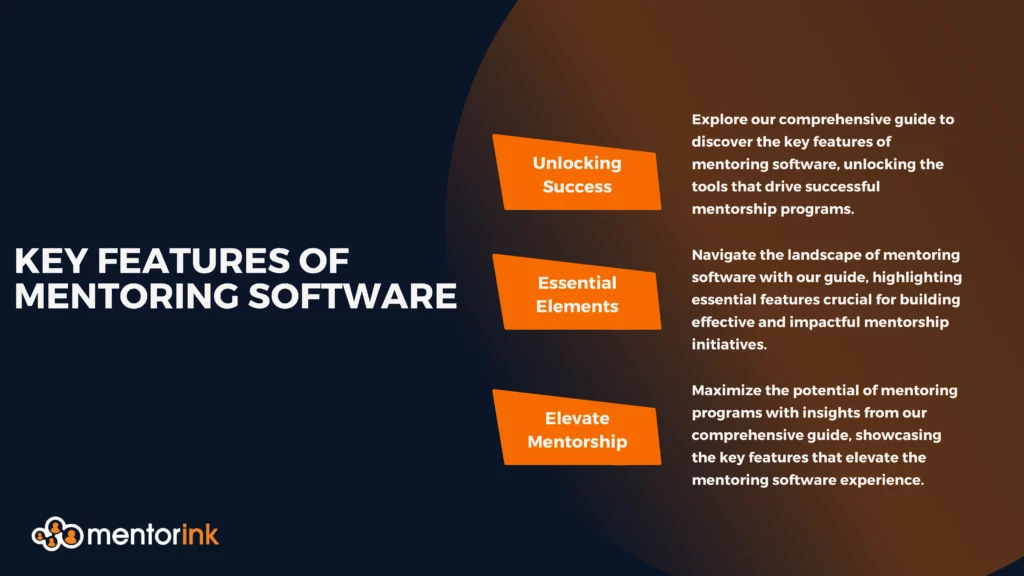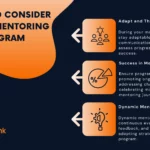
“Why did the developer break up with his girlfriend who was a designer?
Because she kept moving his key features to the bottom of the page!” once said “ChatGPT”.
In an earlier article, we defined mentoring software as a technology platform that facilitates the organisation and management of effective mentoring programs, including matching mentors & mentees, scheduling sessions and tracking progress.
By the way if you are unfamiliar with the concept of mentoring software, you can read our article explaining what mentoring software is to learn more.
In this comprehensive guide, we will demystify the key features of mentoring software.
Let’s get to it.
Basic Key Features of Mentoring Software
User profiles and registration🧍🏻♂️🧍🏻♀️
User profiles and registration are key features of mentoring software that can help ensure that mentees and mentors are matched effectively based on their skills, experience, and interests. This key feature allow individuals to create a digital representation of themselves that can be used to match them with compatible mentors or mentees. The registration process typically involves providing information such as job title, department, years of experience, areas of expertise, and the type of mentoring sought.
Therefore, mentoring software can offer various options for creating user profiles and registration, ranging from basic to more advanced systems that allow for a more in-depth profile creation process.
Communication tools as a key feature 🌏
Communication tools are another key features of mentoring software that enable mentors and mentees to communicate with each other and collaborate effectively. Mentoring relationships often require regular communication between the mentor and mentee to track progress, provide feedback, and share resources. Communication tools provide a digital platform for communication and can include the following features:
- Instant messaging: Mentoring software can include instant messaging tools that allow mentors and mentees to communicate with each other in real-time. This can facilitate quick and efficient communication between the mentor and mentee.
- Video conferencing: Video conferencing tools allow mentors and mentees to communicate face-to-face, even if they are in different locations. This can provide a more personal touch to the mentoring relationship and allow for more in-depth discussions.
- Discussion forums: Discussion forums allow mentors and mentees to post questions, share resources, and collaborate with each other in a group setting. This can facilitate group learning and provide a platform for mentors and mentees to share knowledge with each other.
- Document sharing: Document sharing tools allow mentors and mentees to share files, such as training materials or work samples. This can facilitate learning and help the mentee to apply what they have learned in their day-to-day work.
- Scheduling tools: Scheduling tools allow mentors and mentees to schedule appointments and keep track of their meetings. This can help ensure that mentoring sessions are scheduled and attended in a timely manner.
Overall, communication tools are a key features of mentoring software that can help facilitate effective mentoring relationships by providing a platform for mentors and mentees to communicate, collaborate, and share knowledge with each other.
Scheduling and calendar integration 📅
The other key features of mentoring software is scheduling and calendar integration. Calendar integration allows for easy synchronization with existing calendar tools, such as Google Calendar, to ensure that both parties are aware of upcoming mentoring sessions and can plan their schedules accordingly.
Here are some key benefits of scheduling and calendar integration in mentoring software:
- Time Management
- Accountability
- Easy Scheduling
- Efficiency
- Customization
In a word, mentoring software can offer different options for scheduling and calendar integration, ranging from basic tools that allow for manual scheduling to more advanced tools that automate the process and integrate with existing calendar tools.
Progress tracking and reporting 📊
The last one is progress tracking and reporting that allow mentors and mentees to track their progress, identify areas for improvement, and report on their achievements. Progress tracking tools can help mentors and mentees stay on track with their goals, monitor their progress, and assess their performance over time. Reporting tools can help mentors and mentees share their progress with others, such as program administrators or supervisors, and demonstrate the impact of the mentoring relationship.
Here are some key benefits of progress tracking and reporting in mentoring software:
- Goal Setting
- Performance Assessment
- Evaluation
- Accountability
- Personalization
To summarize, mentoring software can offer different options for progress tracking and reporting, ranging from basic tools that allow for manual tracking and reporting to more advanced tools that automate the process and provide detailed analytics.
Advanced Key Features of Mentoring Software
Matching algorithms and recommendations🎯
Matching algorithms can help match mentors and mentees based on their individual preferences, goals, and experiences. It can use a variety of criteria to determine the best matches, such as skill set, personality, interests, and availability. Recommendations can help mentors and mentees find potential matches and suggest relationships that they may not have considered otherwise.
Here are some key benefits of matching algorithms and recommendations in mentoring software:
- Improved Matches
- Time Efficiency
- Diversity
- Personalization
- Feedback
To sum up, matching algorithms and recommendations, ranging from basic tools that use manual matching to more advanced tools that use machine learning and artificial intelligence. Thus it can help mentors and mentees find the most compatible matches and promote more productive and diverse mentoring relationships.
Integration with other systems and tools 📲
Another key point is integration with other systems and tools that allows it to work seamlessly with other tools and platforms that mentors and mentees use on a daily basis. Accordingly it can help mentors and mentees streamline their workflow, save time and effort, and make the most of their mentoring relationship.
Here are some key benefits of integration with other systems and tools in mentoring software:
- Streamlining Workflow:
Integration can help mentors and mentees streamline their workflow by allowing them to access information between different platforms more easily. - Enhancing Productivity:
Integration can save time and effort, allowing mentors and mentees to focus on achieve their goals more effectively. - Convenience:
Integration can provide a more convenient and user-friendly experience for mentors and mentees by allowing them to access all the tools and resources they need in one place. - Customization:
Integration can be customized to suit the specific needs of the mentor and mentee, such as integrating with specific communication tools. - Improved Data Analysis:
Integration can provide valuable data and insights that can be used to improve the effectiveness of the mentoring program.
Mentoring software can offer different options for integration with other systems and tools, such as integrating with popular communication tools like Zoom or scheduling platforms like Google Calendar.
Feedback and evaluation tools 🚀
Feedback tools can provide a mechanism for mentors and mentees to provide feedback to each other, such as through surveys or questionnaires. While evaluation tools can help program administrators or supervisors assess the effectiveness of the mentoring program as a whole.
Here are some key benefits of feedback and evaluation tools in mentoring software:
- Improvement
- Program Evaluation
- Accountability
- Transparency
- Customization
Overall, this feature can help mentors and mentees identify areas for improvement and provide valuable insights for program improvement.
Resource libraries and knowledge sharing 📚
It can offer a variety of materials, such as guides, templates, and checklists, while knowledge sharing tools can provide a platform for mentors and mentees to share information and insights.
Here are some key benefits of resource libraries and knowledge sharing in mentoring software:
- Accessibility
- Knowledge Transfer
- Collaboration
- Efficiency
- Customization
Choosing the Right Mentoring Software
Factors to consider when evaluating mentoring software
When evaluating mentoring software, there are several key factors to consider. Here are some of the most important factors to keep in mind:
- User Experience: It should be user-friendly and easy to navigate, with clear and concise instructions for both mentors and mentees.
- Functionality: The software should provide all the necessary features and functionality required to support effective mentoring relationships, such as communication tools, scheduling and calendar integration, progress tracking and reporting, and feedback and evaluation tools.
- Customization: It should be customizable to suit the specific needs of the organization and the mentoring program, allowing for greater flexibility and personalization.
- Integration: It should be able to integrate with other systems and tools used by the organization, such as HR systems, learning management systems.
- Security: The software should provide robust security features, such as data encryption, multi-factor authentication, and user access controls, to ensure that confidential information is protected.
- Support: The software provider should offer comprehensive support services, such as training, onboarding, and technical support, to ensure that users are able to effectively use the software.
- Cost: The software should be priced competitively and provide good value for money, taking into account factors.
- Analytics: The software should provide robust analytics and reporting features, allowing program administrators to track program metrics and identify areas for improvement.
Best practices for implementing and using mentoring software
Implementing and using mentoring software can be a highly effective way to support and manage mentoring relationships within your organization. Here are some best practices for implementing and using mentoring software:
- Define your goals and objectives:
Before implementing mentoring software, it’s important to clearly define your program goals and objectives. This will help you to identify the features and functionality that are most important for your organization. - Train users:
Make sure that all users of the mentoring software, including mentors and mentees, are properly trained on how to use the software. - Communicate effectively: Communication is key to successful mentoring relationships, and it’s no different when using mentoring software. Make sure that all users understand the importance of effective communication, and that they are encouraged to communicate regularly using the software.
- Monitor progress and provide feedback:
Regularly monitoring progress and providing feedback is essential for maintaining momentum and ensuring that mentoring relationships stay on track. Then use the mentoring software to track progress and provide regular feedback to mentors and mentees. - Encourage participation
Encourage all users to actively participate in the mentoring program by using the software to communicate, and provide feedback. - Continuously evaluate and improve:
Regularly evaluating the effectiveness of the mentoring program and the mentoring software is essential for identifying areas of improvement and making changes to ensure ongoing success.
By following these best practices, organizations can effectively implement and use mentoring software to support and manage mentoring relationships, improve the overall effectiveness of their mentoring program, and achieve their program goals and objectives.
Conclusion
Recap of key points
Sure! Here’s a recap of the key points covered in this guide on mentoring software:
Key features of mentoring software include user profiles and registration, communication tools, scheduling and calendar integration, progress tracking and reporting, matching algorithms and recommendations, feedback and evaluation tools, resource libraries and knowledge sharing, and integration with other systems and tools.
Benefits of mentoring software include improved mentoring outcomes, increased scalability and accessibility, higher engagement and satisfaction rates, and lower administrative burden and costs.
Best practices for implementing and using mentoring software include defining your goals and objectives, training users, communicating effectively, monitoring progress and providing feedback, encouraging participation, and continuously evaluating and improving.
As a result, mentoring software can be a highly effective way to support and manage mentoring relationships within an organization, and can help to improve the overall effectiveness of mentoring programs while reducing administrative burden and costs.
Call to action for trying out mentoring software.
After all, if you’re interested in improving the effectiveness and scalability of your mentoring program, I encourage you to try out some of the popular mentoring software solutions. Thus by implementing mentoring software, you can benefit from a wide range of features and benefits that can help to support and manage mentoring relationships, improve mentoring outcomes, and reduce administrative burden and costs.
Hence, I recommend that you research some of the popular mentoring software solutions, evaluate them based on your specific needs and goals, and select a solution that best fits your organization’s needs. Once you’ve selected a solution, make sure to follow the best practices for implementing and using mentoring software that were covered in this guide.
Sounds exciting?
We would be very happy to support your design and run your mentoring programs
Book your Demo

